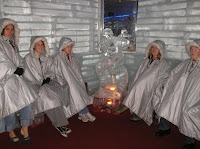 Banteay Srei
Banteay Srei Getting ready to climb Ta Keo.
Getting ready to climb Ta Keo. Abby and Heather heading down one of the temples.
Abby and Heather heading down one of the temples. Abby and me at with a couple of the faces at Bayon.
Abby and me at with a couple of the faces at Bayon. Abby and I in front of Angkor Wat.
Abby and I in front of Angkor Wat.
We flew to Siem Reap, which is known for the temple complexes there, the most famous of which is Angkor Wat. During the reign of King Suryavarman II (1112-52), he built Angkor Wat as a holy ca pital city. Most of the temples have scenes from Hinduism, so I learned a lot about Brahma and Vishnu as well as the story of the churning of the ocean of milk, all of which play a big part in Hinduism. Over the centuries as Cambodia became more Buddhist, some of the Hindu carvings were scratched out or Buddhas were added to the carvings. In some cases, the way that the Hindu gods were sitting as they meditated was changed so it looked more like the way Buddhists sit when they meditate.
We had a guide and a driver with an air-conditioned van for 3 of our days there, which was really nice since it can take a little while to get to the different temples and would have been a hot and dusty ride in a tuk-tuk, on a motorcycle, or on a bike.
The first temple we went to was Banteay Srei, known as the Citadel of Women and dedicated to Shiva. It's smaller than most of the other temples, but has really intricate carvings and, according to Lonely Planet, may have been the instigator of the Khmer art movement. Next we went to the temples of East Mebon, Pre Rup, Banteay Kdei, and Ta Prohm. Ta Prohm is pretty famous because it's so picturesque. It still has a lot of the jungle trees and vines holding it together (and it was used in the Tomb Raider movie with Angelina Jolie!). We also went to Ta Keo, which I climbed to the top of, and Preah Kahn. Preah Kahn was originally a Buddhist complex housing over 1000 Buddhist teachers and is another temple that's still being reclaimed from the jungle, which makes it very cool to wander around in (and it makes me feel like Indiana Jones!).
The next day was a shorter trip to the temples. We went to a group of temples knows as the Roluos group. The temples there were built during the reign of King Indravarman I (877-89). First we went to Preah Ko, which means Sacred Bull. Then we went to Bakong and then Lo Lei. That afternoon we went to a fishing village on Tonle Sap, a huge lake in Cambodia that provides over 80% of the Cambodian population's protein.
The day after that, another SIS teacher, Aaron, came to Siem Reap, so we finally hit the big temples. We started out at Angkor Thom, which is a walled compound with lots of temples inside its walls. It was built during the reign of King Jayavarman VII (1181-1219). After starting at the South Gate, we went to The Bayon, which was the king's state temple. This temple is famous for its 54 towers with 216 carved faces. There are also lots of carvings showing daily life in the king's court and battles. Next we went to The Baphuon, which was built between 1049-65. At the end of the 15th century, it was turned from a Hindu to a Buddhist temple and one of the walls was made out of dismantled towers to create a 70 meter long reclining Buddha. Next we walked around what had been the Royal Palace (the palace was made of wood, so all that remains today is the walls and pools) and then went to the Terrace of the Leper King, (it may be named that because a statue on it may represent a king who died of leprosy). After that we went to the Terrace of Elephants, which has, not surprisingly, lots of statues of elephants.
After lunch, we went to Angkor Wat, the largest religious complex in the world. It was built during the reign of King Suryavarman II (1112-1152). It has moats and walls and carvings showing various Hindu stories. It's absolutely beautiful and wasn't very crowded when we were there, which was nice. We were there during the low season, so it was nice to be able to walk around Angkor Wat without a ton of other people there. That evening we went to a hill nearby Angkor Wat to watch the sun set.
The next day, Abby left for Bangkok, so it was just Heather, Aaron, and me. We went to Kbal Spean, a site about 50 kilometers away from Siem Reap. It's an river bed that had been carved with Buddhas and lingas, which are Hindu fertility symbols. The carvings were fine, but it was cool to get to hike through the jungle a bit to get there. Then we went back to Banteay Srei so Aaron could see it.
The next day Heather and I got on a plane for Laos, which Aaron spent one more day in Siem Reap. He met up with us in Laos the next day.
 Francie, Heather, and I enjoying some Thai food.
Francie, Heather, and I enjoying some Thai food. An action shot during the game.
An action shot during the game. This year's shirts.
This year's shirts.














































